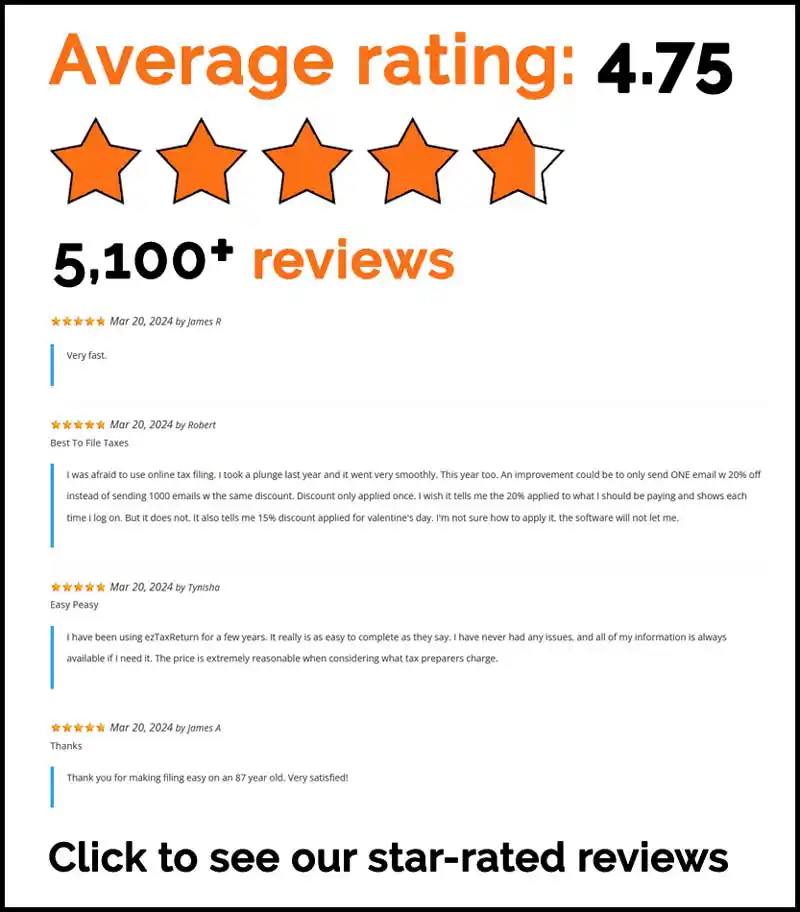The information in this article is up to date for tax year 2024 (returns filed in 2025).
Do you want to save money on your tax return? Well, then don’t miss out on valuable tax deductions. Using tax software to prepare your return will make life a lot easier, especially now that it’s crunch time. ezTaxReturn can help you find last-minute deductions you may have overlooked and help you claim them.
Here are some last-minute tax deductions you don’t want to miss.
Medical and Dental Expense Deduction
If you are itemizing deductions, the IRS lets you deduct a portion of your medical and dental expenses on your tax return, so keep your receipts. The expenses must be related to the diagnosis, cure, treatment or prevention of a disease. You can include things like the cost of eye exams, hearing aids, in vitro fertilization, therapy and more.
For tax year 2024, you can deduct any expenses for you, your spouse and dependents that are more than 7.5% of your adjusted gross income. If you have medical bills that weren’t covered by insurance, ezTaxReturn can help you claim the deduction and lower your tax bill.
IRA Deduction
The contributions you make to a traditional individual retirement account (IRA) are often deductible. However, your deduction may be limited if:
- You or your spouse are covered by a retirement plan at work
- Your modified adjusted gross income (MAGI) exceeds the annual limits
While contributions to a Roth IRA are made with after-tax dollars and do not provide an upfront tax deduction, the funds grow tax-free and can be withdrawn tax-free during retirement, offering long-term benefits.
Act fast because you only have until April 15, 2025 to make 2024 IRA contributions. The maximum you can contribute is $7,000 ($8,000 if you are aged 50 plus). These annual limits are for combined contributions. So if you have both a traditional IRA and a Roth IRA, you can’t contribute more than $7,000 across both accounts for the year.
Student Loan Interest Deduction
If you made student loan payments for you, your spouse or your dependent last year, up to $2,500 of the interest you paid is deductible. Best of all, you don’t need to itemize to claim the deduction. Make sure you receive a 1098-E, or student loan interest statement, from your lender to report on your tax return.
To qualify for the full deduction, borrowers must make less than $80,000. Those who earn up to $95,000 in income can claim a partial deduction.
Read more: How to File Taxes as a Student
Educator Expense Deduction
Educators can deduct up to $300 of out-of-pocket classroom expenses on their federal tax return. If you and your spouse are both educators and you file a joint tax return, the deduction limit doubles to $600.
Educators can deduct the cost of professional development courses, books, supplies and computer equipment. You can also include items bought to prevent you and your students from spreading COVID-19 around the classroom. For example, face masks, hand sanitizer, disposable gloves, disinfectant and other items recommended by the Centers for Disease Control and Prevention (CDC)
To qualify for the educator expense deduction, you must
- Be a K-12 teacher, principal, counselor, instructor, or aide
- Work for at least 900 hours a school year
- Work in in a school that provides elementary or secondary education as determined under state law
Be sure to keep track of what you bought and how much you paid, so you can deduct it on your taxes.
Mortgage Interest Deduction
Paying your mortgage can help you save money on your taxes if you choose to take itemized deductions. Homeowners who itemize can deduct the interest paid on mortgages up to $750,000 ($375,000 for married couples filing separate) for homes purchased after 2017. If you purchased your home before December 15, 2017, the cap is $1 million ($500,000 if married filing separately).
The loan must be used to buy, build or significantly improve your main or second home. By now, your mortgage lender should’ve mailed you a Form 1098 detailing how much you paid in mortgage interest and points last year. ezTaxReturn can walk you through the steps of claiming your deduction.
Charitable Contribution Deduction
Did you know that donating to your favorite charity can reduce your taxable income? That’s right! Doing a good deed for someone else can be beneficial for you too. You can deduct money or property given to:
- Charities like Boys & Girls Clubs of America, Goodwill, American Red Cross, United Way, Salvation Army, CARE, etc.
- Nonprofit organizations that maintain public parks
- Nonprofit schools, hospitals, and museums
- Churches, mosques, synagogues, temples, and other religious organizations
- Volunteer fire companies
Keep track of your donations, no matter how big or small the amount. Hold on to any receipts, bank statements or credit card statements that show the organizations name, the amount you donated and the date. Donations of $250 or more also require you to get a written letter from the charity. You must itemize to claim your charitable contributions.
While you must itemize to claim your charitable contributions, it’s important to compare this with the standard deduction to determine which option provides the greater tax benefit.
Home Office Deduction
Home office expenses are deductible, but only for those who are self-employed. Your home office must also meet certain standards to qualify. For instance, the office must be regularly and exclusively used for business purposes. If the room serves as a part-time guest room, craft room or play area for your kids, you cannot claim the deduction. The rules also state that the space must be the main place where you meet with clients. Using the simplified method, you can deduct $5 per square foot of your home office up to 300 square feet, or $1,500.
Contribute to a Health Savings Account (HSA)
Contributing to a Health Savings Account (HSA) is a smart way to reduce your taxable income and lower your tax liability. An HSA is a tax-advantaged savings account that allows you to set aside money on a tax-free basis to pay for qualified medical expenses. Contributions to an HSA are tax-deductible, and the funds grow tax-free. Plus, withdrawals from an HSA are tax-free if used for qualified medical expenses.
To be eligible for an HSA, you must have a high-deductible health plan (HDHP) and not be enrolled in any other health coverage, including Medicare or Medicaid. For 2024, the annual contribution limits for HSAs are $4,150 for individuals and $8,300 for families. If you’re 55 or older, you can also make catch-up contributions of up to $1,000.
By contributing to an HSA, you can effectively reduce your taxable income and lower your tax bill. For instance, if you contribute $3,000 to an HSA in 2024, you can deduct that amount from your taxable income, resulting in significant tax savings.
Minimize Capital Gains Tax
Capital gains tax can be a significant burden for investors, but there are strategies to minimize it and reduce your tax liability. One effective way is to hold onto your investments for at least a year before selling them. Long-term capital gains are generally taxed at a lower rate than short-term capital gains, which can lead to substantial tax savings.
Another strategy is to offset your gains with losses through tax-loss harvesting. If you have investments that have declined in value, selling them to realize a loss can offset your gains, reducing your overall tax liability. Additionally, donating appreciated securities to charity can help you avoid capital gains tax while providing a charitable deduction.
Keep in mind that capital gains tax rates vary depending on your income tax bracket. Higher income brackets may be subject to higher capital gains tax rates, so it’s essential to plan accordingly to minimize your tax burden.
Claim the Clean Vehicle Credit
The Clean Vehicle Credit, part of the Inflation Reduction Act, offers a substantial tax incentive for individuals looking to adopt eco-friendly technologies. This credit provides up to $7,500 for the purchase of an eligible electric vehicle, making it an attractive option for those aiming to reduce their carbon footprint.
To qualify for the Clean Vehicle Credit, you must purchase an eligible electric vehicle and meet specific income and eligibility criteria. The credit begins to phase out for taxpayers with incomes above $150,000 for single filers and $300,000 for joint filers. By taking advantage of this credit, you can significantly lower your tax liability while contributing to environmental sustainability.
File your taxes now with ezTaxReturn. We ask simple questions to determine which deductions you qualify for and complete all the proper forms and calculations. 100% accuracy, guaranteed.
The articles and content published on this blog are provided for informational purposes only. The information presented is not intended to be, and should not be taken as, legal, financial, or professional advice. Readers are advised to seek appropriate professional guidance and conduct their own due diligence before making any decisions based on the information provided.




